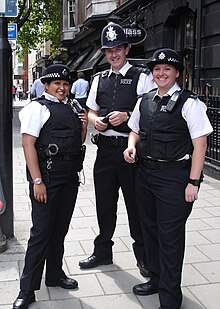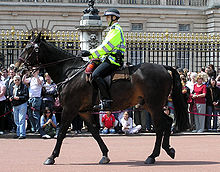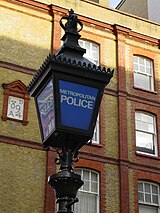Metropolitan Police Service
|
|||
|---|---|---|---|
|
|
|||
| State level | Greater London | ||
| Consist | since September 29, 1829 | ||
| Headquarters | London | ||
| MPS Commissioner | Cressida Dick | ||
| Website | www.met.police.uk | ||
The Metropolitan Police Service ( MPS ; commonly referred to as the Metropolitan Police or colloquially as The Met ) is the police agency of Greater London (with the exception of the City of London , which has its own police force, the City of London Police ). In 2005 the Metropolitan Police had 30,625 police officers.
The headquarters of the Metropolitan Police are located in New Scotland Yard in Westminster . Scotland Yard is also often used as a metonym for the Metropolitan Police Service . The British Transport Police ensure safety on all public transport. The Royal Parks Constabulary , which is responsible for security in the royal parks , is now part of the Metropolitan Police. The Chief of Police is the Commissioner of Police of the Metropolis (usually referred to simply as the Commissioner).
history
The Metropolitan Police was founded on September 29, 1829 by the then Home Secretary Robert Peel , which gave the police officers the nicknames "Peelers" and "Bobbies". The Metropolitan Police was the first official, non- paramilitary police agency in the world.
There was no police force in London at all until the middle of the 18th century. Peace and order were magistrates , voluntary Wachtmeister ( constables ), night watchman and - maintained by the military - where necessary. If the victim of a crime wanted the perpetrator to be prosecuted, they could hire a thief taker who earned a living from rewards and bounties.
The writer Henry Fielding was appointed magistrate of the City of Westminster in 1748 . His house at 4 Bow Street had been converted into a courtroom in 1739 by his predecessor Thomas de Veil . Fielding gathered a group of eight trustworthy constables and authorized them to enforce the magistrates' decisions. Fielding's blind half-brother, John Fielding, followed in 1754 as magistrate and transformed the patrol into the first truly effective police force, the Bow Street Runners. In 1798, the Marine Police was established in Wapping , a private security company that patrolled the docks and investigated cargo theft. This police force later merged into the “Thames Division” of the Met and is now the river police.
During the early 19th century, London's population grew rapidly due to the industrial revolution . The system of locally organized police forces turned out to be increasingly inefficient for a constantly growing metropolis. In 1829 the House of Commons passed the Metropolitan Police Act , which placed police in the capital directly under the Ministry of the Interior. Initially, the Metropolitan Police consisted of 1,000 police officers whose job it was to prevent and solve crimes within a seven mile radius of Charing Cross .
The Met remained under direct control of the Home Office until 2000, when responsibility was transferred to the newly created Greater London Authority . The supervision is carried out by an authority called the "Metropolitan Police Authority". This is composed of the Mayor of London and several independent members. The police chief is still appointed by the interior minister.
Organizational structure
The Metropolitan Police consists of five main directorates, each headed by an Assistant Commissioner or, in the case of the Administrative Directorate, a Director of Police. There are the main directorates, Territorial Policing , Specialist Crime Directorate , Specialist Operations , Central Operations, and Administration and Support .
The Metropolitan Police is directed by a Management Board consisting of the Commissioner, the Deputy Commissioner and the Heads of the Principal Directorates. Sir Paul Stephenson was Police Commissioner until his resignation on July 17, 2011 , when he came under fire for the News of the World telephone bugging scandal . Cressida Dick CBE is currently the Commissioner. In 2017, she became the first woman in the line of previous incumbents.
Territorial policing
The Territorial Policing (TP) Directorate is headed by Assistant Commissioner Simon Byrne. It is responsible for everyday work. The area of responsibility of the Metropolitan Police (Metropolitan Police District) is divided into 32 Borough Operational Command Units (BOCU). The division of the police districts is congruent with the city districts. The police districts are headed by a Chief Superindent or Commander (BOCU Westminster). The BOCU are responsible for all police tasks in their district. The TP also reports to the Royal Parks Operational Command Unit and the Safer Transport Command .
Prior to April 1, 2000, the Metropolitan Police also operated in a number of areas outside Greater London, in parts of Essex , Hertfordshire and Surrey . Since then, the boundary of the Metropolitan Police District has been exactly the same as that of Greater London, with the exception of the City of London.
Borough Operational Command Units
The letters in brackets are worn on epaulettes to indicate affiliation, the number indicates the number of officials:
|
|
Police stations
In addition to the headquarters at New Scotland Yard, there are 140 police stations. There are areas that are manned around the clock, those with day duty or those that are only open a few days a week. The oldest police station was on Bow Street . It was established in 1881 and closed in 1992, with the attached Bow Street Magistrates Court remaining until July 14, 2006. The oldest still existing area is that in Wapping. It was established in 1908. This is where the headquarters of the " Marine Support Unit ", which is responsible for the Thames, are located, a morgue and the river police museum. The area in Paddington Green, which has underground accommodation for terrorist suspects, is also known.
In many districts there is still the blue lamp introduced in 1861 for identification.
The districts are staffed differently. Possible occupations are
- the uniformed police on patrol duty and in prevention,
- "Police Community Support Officer" who show presence in the area and support the patrol duty,
- Safer Neighborhood Team, composed of regular and volunteer police officers,
- Traffic monitoring in stationary traffic,
- Prevention officers who are not police officers and who advise on crime prevention
- Weapons investigators who are not police officers but who investigate firearms regulations and are responsible for weapons permits,
- Administrative employees
- Archive employees
- Police student
- Metropolitan Special Constabulary Police Volunteers
- Criminal Investigation Department (CID). This department is headed by a Detective Chief Inspector and is staffed with Detective Constables, Detective Sergeants and Detective Inspectors.
Many precincts have holding cells.
Specialist groups
The Metropolitan Police has various specialist groups in the “Specialist Operations” (SO) department, which were formed in 1986 from different departments. Of the original 20 groups, only a few have remained in the course of time.
- SO1: Special protection (Specialist Protection, merged with SO14 as "Protection Command")
- SO2: Crime Support Branch / Department Support Group
- SO3: Tatortgruppe, Directorate for Forensic Services (Scenes of Crime Branch / Directorate of Forensic Services, now part of the Specialist Crime Directorate as SCD4 Forensic Services)
- SO4: National Identification Service
- SO5: Miscellaneous Force Indexes / Child Protection (now SCD5 Child Abuse Investigation Team)
- SO6: Fraud Squad (now SCD6 Economic and Specialist Crime)
- SO7: Serious and Organized Crime (renamed Serious and Organized Crime Group, SCD7)
- SO8: Forensic Science Laboratory
- SO9: Flying Squad (with the same name and tasks, now referred to as SCD7).
- SO10: Crime Operations Group (now SCD10 Covert Policing)
- SO11: Criminal Intelligence Branch (renamed Public Order Operational Command Unit, CO11)
- SO12: Special Branch (merged with SO13 as Counter Terrorism Command)
- SO13: Anti-Terrorism Branch (merged with SO12)
- SO14: Royalty Protection Branch (merged with SO1)
- SO15: Counter Terrorism Command
- SO16: Diplomatic Protection Group (now part of the Protection Command).
- SO17: PNC Bureau (now Police Information Technology Organization)
- SO18: Aviation Security / Airport Policing (now: Aviation Security Operational Command Unit, CO18 in the Central Operations department)
- SO19 : Force Firearms Unit (now: Specialist Firearms Command, CO19)
- SO20: Forensic Medical Examiners Branch
There is also the Central Operations department , which also provides specially trained police officers.
Ranks
Tug of war team at the Olympic Games
The Metropolitan Police's tug of war team won bronze at the 1908 Summer Olympics , when three police teams competed for the United Kingdom.
Web links
Individual evidence
- ↑ Scotland Yard boss resigns , message from July 17, 2011 on sueddeutsche.de
- ↑ London police chief takes his hat in: NZZ Online from July 18, 2011
- ↑ List of districts
















